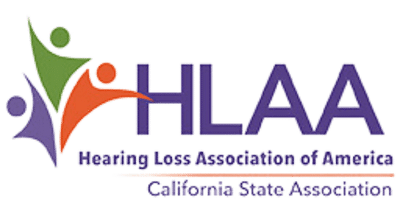An Exciting Update!
May, 2022

Thanks to the ongoing efforts of Janice Armigo Brown, BATF Vice Chair and HLAA-CA Director, the BART system in the Bay Area is nearing completion of its efforts to have all stations and rail cars looped.
This project was launched in 2017 with the first hearing loop installation at Fremont Station. As of Winter 2021-22, eight stations remained to be completed. Other upgrades to stations are ongoing, including refurbishing and reopening of restrooms. A recent ceremony at Powell Street Station showcased the upgrades—note the t-coil signage behind Ms Armigo Brown at the service desk.
Also, by Spring 2022, more than 40% of the 775 new Fleet of the Future rail cars were in service featuring clearly market seating in the designated looped area.
 This article originally appeared in The Hearing Loss Californian, Fall 2017.
This article originally appeared in The Hearing Loss Californian, Fall 2017.
Train stations are noisy places where most transit riders struggle to hear PA announcements and conversation at ticket windows. Now BART (Bay Area Rapid Transit) is testing an induction loop system at the Fremont Station. In a pilot program, both the platform and the station agent’s booth are now equipped with induction loop technology. A hearing loop is a transmitter attached to a thin wire which is installed around the outer edge of an area, typically a room, and converts sound into a magnetic signal. At Fremont Station, one loop is at the perimeter of the platform and along the yellow boarding strip. A smaller loop is at the booth.
Most modern hearing aids are equipped with an internal antenna called a telecoil or T-coil which receives the magnetic signal and converts it back into sound. Riders toggle a switch on their aids to hear much clearer PA announcements and interactions with the station agent. “It’s like wifi for your ears,” said Richard McKinley, managing director of Contacta Inc., which is the contractor’s vendor supplier on the pilot project.
Carl Orman, project manager for the installation, said the idea for looping came through collaboration with the BART Accessibility Task Force. It has taken several years to plan and realize this BART project which was originally proposed for the recently opened Warm Springs Station. Mr. Orman also serves as BART’s accessibility program manager in the Office of the District Architect.

HLAA member Janice Armigo Brown has been a member of the BART Accessibility Task Force since 2012 and uses a hearing aid with T-coil technology. She first championed looping a BART station after experiencing the technology at the HLAA convention in 2013. She pointed out that it took time to become educated about what induction loop technology entails and how it works. Once she had learned enough, she became an advocate for looping and worked to share her knowledge with BART decision makers. Public areas like train stations have dense structures of concrete, steel and miles of wiring. Engineering a loop solution for an existing structure is much more complicated than designing a new platform with integrated technology.
“In public transit situations such as BART, noise can be a huge factor,” Ms. Brown said. “People with hearing loss rely on visual cues such as lip-reading to compensate for or ‘fill in the blanks’ when communicating with station agents, transit personnel or other riders when asking questions and obtaining vital information. Any added background noise can prevent a person with hearing loss from understanding or deciphering speech.” Ms. Brown further explained that it is especially stressful when there are special announcements conveying non-routine information.
Several members of the HLAA Diablo Valley chapter tested the Fremont Station loop and gave their reactions in late May. Some said they got good reception through their T-coils, even in areas where most people couldn’t hear announcements such as at the far end of the platform. Others reported problems such as blurry sound quality, audio feedback, and electromagnetic buzzing. Mr. Orman said BART is still working to refine the system, which will remain in an “open-ended” pilot phase.
Making riders aware of the technology will be important. There will be pictogram placards placed in the area indicating that hearing loop technology is available. Many hearing-aid users in America are unfamiliar with loop technology although it has been in use in Europe and Australia, including in transit stations, for many years.
Users who are unsure whether their aids are equipped with T-coil may want to check with their audiologists for more information. If a T-coil is part of the hearing aid, it may be activated with a simple toggle. In some cases, configuration by a professional may be required.
Juliëtte Sterkens, an audiologist based in Wisconsin, is the hearing loop advocate for the Hearing Loss Association of America (HLAA). She explained that hearing aids work best within about six feet from the person talking. “When a large area like a church, museum, library or train platform is looped, the wearer can hear from a much greater distance, as if standing mere inches from the mouth of the speaker.”
“The T-coil in the hearing aid processes the audio and feeds it into the wearer’s ears. The hearing aid can reduce background noise or other acoustic problems,” said Dr. Sterkens. “In T-coil-only mode a person can isolate sound coming through the hearing loop. This is particularly advantageous in a place with a lot of background noise,” she said, adding that some newer hearing aids can be adjusted by a smartphone app. “The hearing aid industry is responding to hearing loop technology as it becomes more widespread in the US,” she said.
“While the hearing loop is a promising technology, it cannot be the solution for all riders with hearing loss,” noted Dr. Ike Nnaji of BART’s Customer Access Department, and liaison to the BART Accessibility Task Force. “For the profoundly deaf or those who do not use hearing aids, alternative delivery of information remains the textual messages that are displayed on the station information signs.”
With an eye to the future, BART is now working with train car manufacturer Bombardier to develop and test an induction loop system for its new replacement fleet of cars.
Janice Armigo Brown has been member of the HLAA-CA Board of Directors since January 2022. She is a dedicated member of the HLAA (East Bay/San Francisco Chapter) and numerous organizations such as the Hearing and Speech Center of Northern California and the Deaf Counseling and Advocacy and Resource Agency. She advocates for others as a member, and now Co-Chair, of the BART Accessibility Task Force for the last 10 years. Today she is the newly elected Hard of Hearing Representative for the Equipment Product Advisory Committee for the California Public Utilities Commission. She has over 20 years of experience in Special Education and is a freelance writer.
This article originally appeared in The Hearing Loss Californian, Fall 2017.



